Nursing Case Analysis: Linda's Leg Ulcer and Diabetes
VerifiedAdded on 2023/01/09
|9
|2639
|20
Case Study
AI Summary
This case analysis report focuses on the nursing care of Linda, a 71-year-old female presenting with a leg ulcer and poorly controlled diabetes. The report utilizes the A2K assessment framework, detailing primary and secondary surveys to identify normal and abnormal clinical findings. Specific nursing assessments, including venogram and duplex ultrasound, are justified based on abnormal findings. The prescribed nursing intervention is sclerotherapy, with an explanation of its explicit indication, safety considerations, and the nurse's role in administering it. The report also highlights the importance of professional and therapeutic relationships, the ICN Code of Ethics, and the nurse's responsibilities in providing high-quality patient care, emphasizing the prevention of illness, alleviation of suffering, restoration of health, and promotion of health in accordance with ethical guidelines.

Case Analysis Case Study
Nursing Interventions
1
Nursing Interventions
1
Paraphrase This Document
Need a fresh take? Get an instant paraphrase of this document with our AI Paraphraser
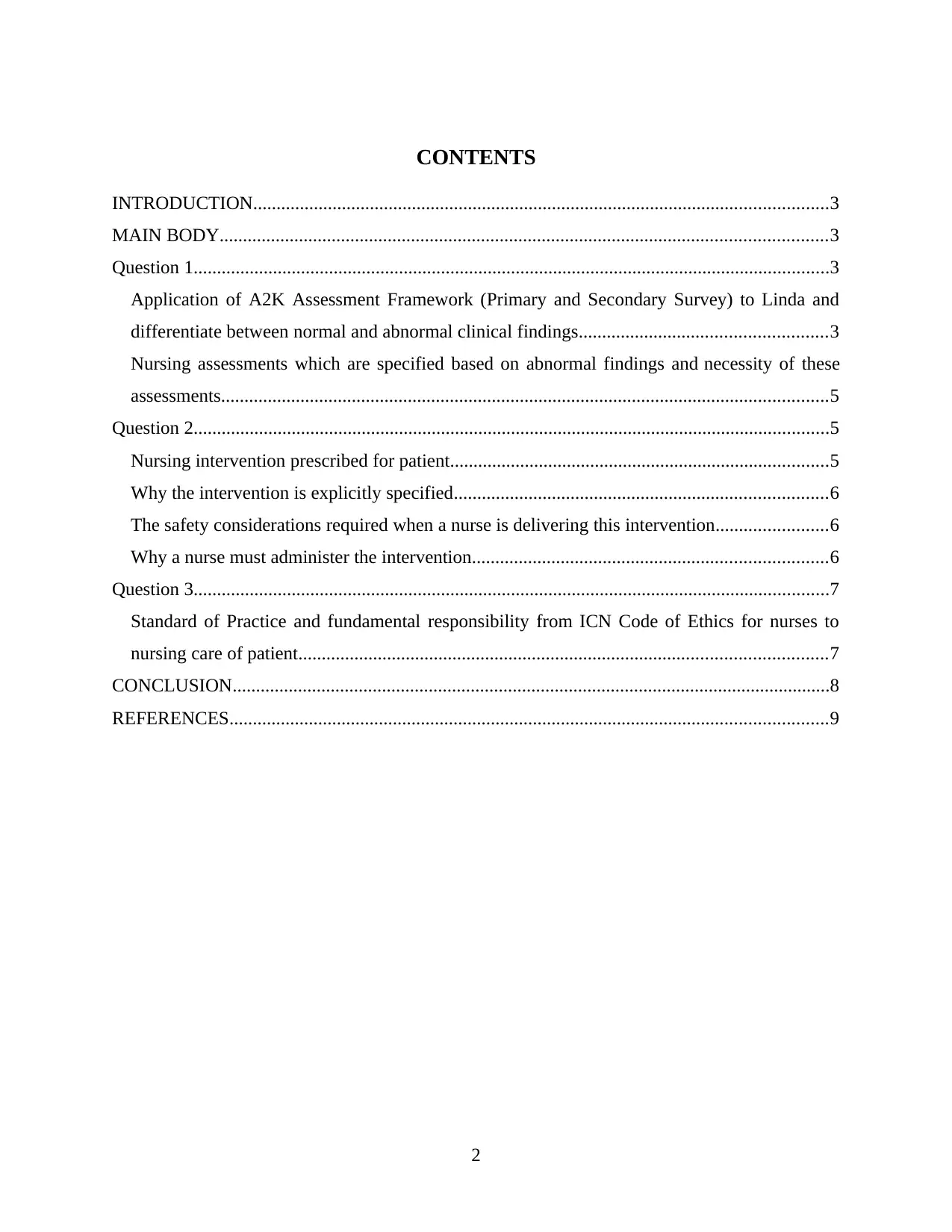
CONTENTS
INTRODUCTION...........................................................................................................................3
MAIN BODY..................................................................................................................................3
Question 1........................................................................................................................................3
Application of A2K Assessment Framework (Primary and Secondary Survey) to Linda and
differentiate between normal and abnormal clinical findings.....................................................3
Nursing assessments which are specified based on abnormal findings and necessity of these
assessments..................................................................................................................................5
Question 2........................................................................................................................................5
Nursing intervention prescribed for patient.................................................................................5
Why the intervention is explicitly specified................................................................................6
The safety considerations required when a nurse is delivering this intervention........................6
Why a nurse must administer the intervention............................................................................6
Question 3........................................................................................................................................7
Standard of Practice and fundamental responsibility from ICN Code of Ethics for nurses to
nursing care of patient.................................................................................................................7
CONCLUSION................................................................................................................................8
REFERENCES................................................................................................................................9
2
INTRODUCTION...........................................................................................................................3
MAIN BODY..................................................................................................................................3
Question 1........................................................................................................................................3
Application of A2K Assessment Framework (Primary and Secondary Survey) to Linda and
differentiate between normal and abnormal clinical findings.....................................................3
Nursing assessments which are specified based on abnormal findings and necessity of these
assessments..................................................................................................................................5
Question 2........................................................................................................................................5
Nursing intervention prescribed for patient.................................................................................5
Why the intervention is explicitly specified................................................................................6
The safety considerations required when a nurse is delivering this intervention........................6
Why a nurse must administer the intervention............................................................................6
Question 3........................................................................................................................................7
Standard of Practice and fundamental responsibility from ICN Code of Ethics for nurses to
nursing care of patient.................................................................................................................7
CONCLUSION................................................................................................................................8
REFERENCES................................................................................................................................9
2
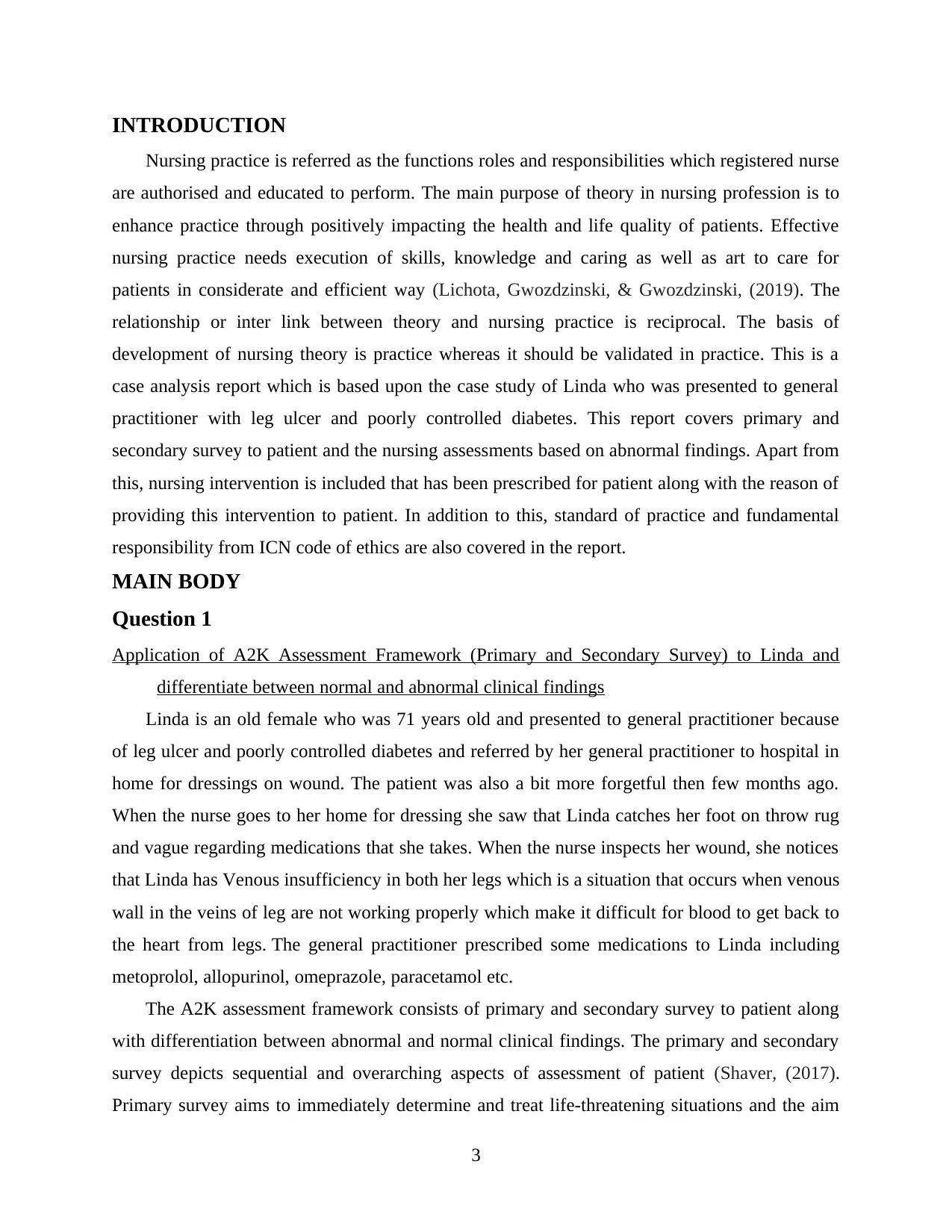
INTRODUCTION
Nursing practice is referred as the functions roles and responsibilities which registered nurse
are authorised and educated to perform. The main purpose of theory in nursing profession is to
enhance practice through positively impacting the health and life quality of patients. Effective
nursing practice needs execution of skills, knowledge and caring as well as art to care for
patients in considerate and efficient way (Lichota, Gwozdzinski, & Gwozdzinski, (2019). The
relationship or inter link between theory and nursing practice is reciprocal. The basis of
development of nursing theory is practice whereas it should be validated in practice. This is a
case analysis report which is based upon the case study of Linda who was presented to general
practitioner with leg ulcer and poorly controlled diabetes. This report covers primary and
secondary survey to patient and the nursing assessments based on abnormal findings. Apart from
this, nursing intervention is included that has been prescribed for patient along with the reason of
providing this intervention to patient. In addition to this, standard of practice and fundamental
responsibility from ICN code of ethics are also covered in the report.
MAIN BODY
Question 1
Application of A2K Assessment Framework (Primary and Secondary Survey) to Linda and
differentiate between normal and abnormal clinical findings
Linda is an old female who was 71 years old and presented to general practitioner because
of leg ulcer and poorly controlled diabetes and referred by her general practitioner to hospital in
home for dressings on wound. The patient was also a bit more forgetful then few months ago.
When the nurse goes to her home for dressing she saw that Linda catches her foot on throw rug
and vague regarding medications that she takes. When the nurse inspects her wound, she notices
that Linda has Venous insufficiency in both her legs which is a situation that occurs when venous
wall in the veins of leg are not working properly which make it difficult for blood to get back to
the heart from legs. The general practitioner prescribed some medications to Linda including
metoprolol, allopurinol, omeprazole, paracetamol etc.
The A2K assessment framework consists of primary and secondary survey to patient along
with differentiation between abnormal and normal clinical findings. The primary and secondary
survey depicts sequential and overarching aspects of assessment of patient (Shaver, (2017).
Primary survey aims to immediately determine and treat life-threatening situations and the aim
3
Nursing practice is referred as the functions roles and responsibilities which registered nurse
are authorised and educated to perform. The main purpose of theory in nursing profession is to
enhance practice through positively impacting the health and life quality of patients. Effective
nursing practice needs execution of skills, knowledge and caring as well as art to care for
patients in considerate and efficient way (Lichota, Gwozdzinski, & Gwozdzinski, (2019). The
relationship or inter link between theory and nursing practice is reciprocal. The basis of
development of nursing theory is practice whereas it should be validated in practice. This is a
case analysis report which is based upon the case study of Linda who was presented to general
practitioner with leg ulcer and poorly controlled diabetes. This report covers primary and
secondary survey to patient and the nursing assessments based on abnormal findings. Apart from
this, nursing intervention is included that has been prescribed for patient along with the reason of
providing this intervention to patient. In addition to this, standard of practice and fundamental
responsibility from ICN code of ethics are also covered in the report.
MAIN BODY
Question 1
Application of A2K Assessment Framework (Primary and Secondary Survey) to Linda and
differentiate between normal and abnormal clinical findings
Linda is an old female who was 71 years old and presented to general practitioner because
of leg ulcer and poorly controlled diabetes and referred by her general practitioner to hospital in
home for dressings on wound. The patient was also a bit more forgetful then few months ago.
When the nurse goes to her home for dressing she saw that Linda catches her foot on throw rug
and vague regarding medications that she takes. When the nurse inspects her wound, she notices
that Linda has Venous insufficiency in both her legs which is a situation that occurs when venous
wall in the veins of leg are not working properly which make it difficult for blood to get back to
the heart from legs. The general practitioner prescribed some medications to Linda including
metoprolol, allopurinol, omeprazole, paracetamol etc.
The A2K assessment framework consists of primary and secondary survey to patient along
with differentiation between abnormal and normal clinical findings. The primary and secondary
survey depicts sequential and overarching aspects of assessment of patient (Shaver, (2017).
Primary survey aims to immediately determine and treat life-threatening situations and the aim
3
⊘ This is a preview!⊘
Do you want full access?
Subscribe today to unlock all pages.

Trusted by 1+ million students worldwide
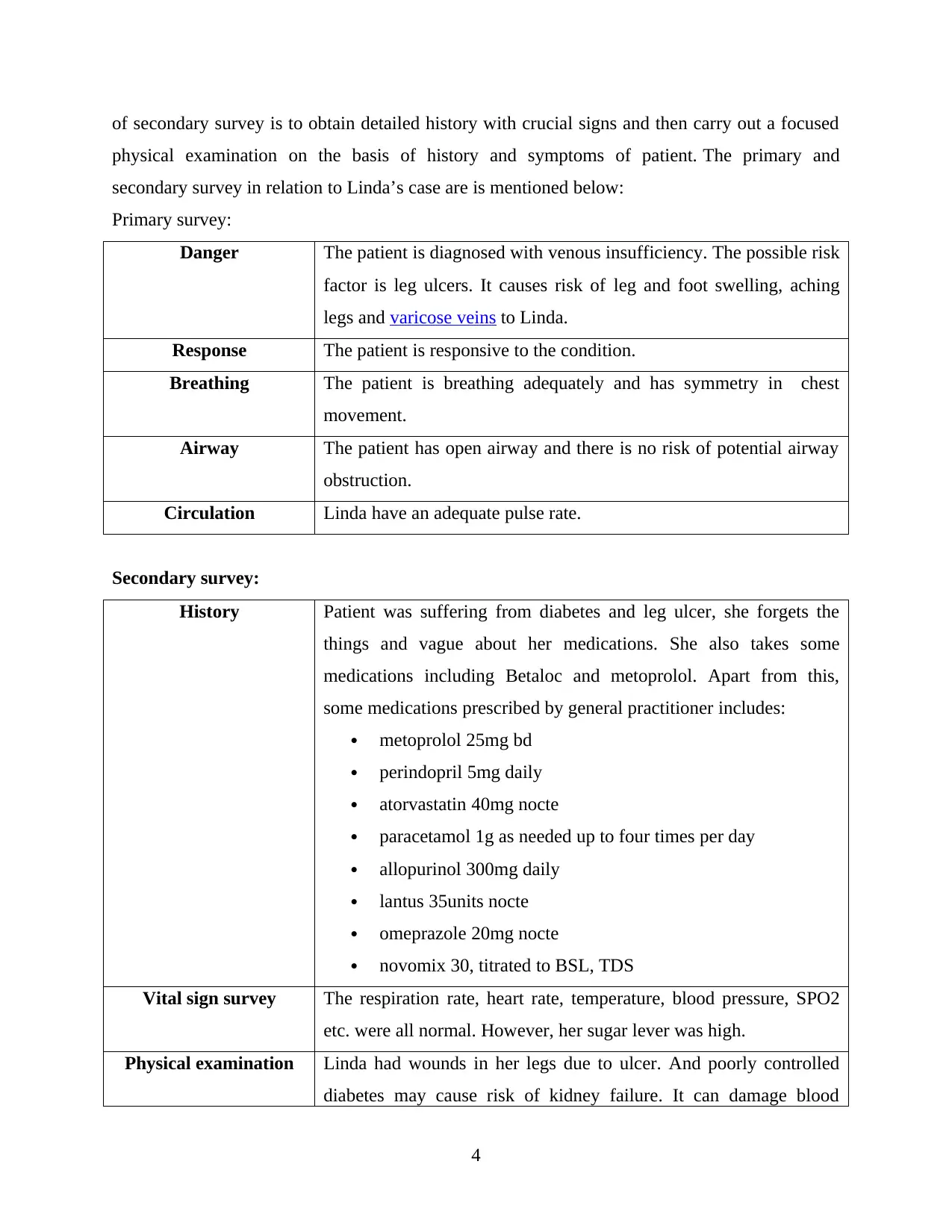
of secondary survey is to obtain detailed history with crucial signs and then carry out a focused
physical examination on the basis of history and symptoms of patient. The primary and
secondary survey in relation to Linda’s case are is mentioned below:
Primary survey:
Danger The patient is diagnosed with venous insufficiency. The possible risk
factor is leg ulcers. It causes risk of leg and foot swelling, aching
legs and varicose veins to Linda.
Response The patient is responsive to the condition.
Breathing The patient is breathing adequately and has symmetry in chest
movement.
Airway The patient has open airway and there is no risk of potential airway
obstruction.
Circulation Linda have an adequate pulse rate.
Secondary survey:
History Patient was suffering from diabetes and leg ulcer, she forgets the
things and vague about her medications. She also takes some
medications including Betaloc and metoprolol. Apart from this,
some medications prescribed by general practitioner includes:
metoprolol 25mg bd
perindopril 5mg daily
atorvastatin 40mg nocte
paracetamol 1g as needed up to four times per day
allopurinol 300mg daily
lantus 35units nocte
omeprazole 20mg nocte
novomix 30, titrated to BSL, TDS
Vital sign survey The respiration rate, heart rate, temperature, blood pressure, SPO2
etc. were all normal. However, her sugar lever was high.
Physical examination Linda had wounds in her legs due to ulcer. And poorly controlled
diabetes may cause risk of kidney failure. It can damage blood
4
physical examination on the basis of history and symptoms of patient. The primary and
secondary survey in relation to Linda’s case are is mentioned below:
Primary survey:
Danger The patient is diagnosed with venous insufficiency. The possible risk
factor is leg ulcers. It causes risk of leg and foot swelling, aching
legs and varicose veins to Linda.
Response The patient is responsive to the condition.
Breathing The patient is breathing adequately and has symmetry in chest
movement.
Airway The patient has open airway and there is no risk of potential airway
obstruction.
Circulation Linda have an adequate pulse rate.
Secondary survey:
History Patient was suffering from diabetes and leg ulcer, she forgets the
things and vague about her medications. She also takes some
medications including Betaloc and metoprolol. Apart from this,
some medications prescribed by general practitioner includes:
metoprolol 25mg bd
perindopril 5mg daily
atorvastatin 40mg nocte
paracetamol 1g as needed up to four times per day
allopurinol 300mg daily
lantus 35units nocte
omeprazole 20mg nocte
novomix 30, titrated to BSL, TDS
Vital sign survey The respiration rate, heart rate, temperature, blood pressure, SPO2
etc. were all normal. However, her sugar lever was high.
Physical examination Linda had wounds in her legs due to ulcer. And poorly controlled
diabetes may cause risk of kidney failure. It can damage blood
4
Paraphrase This Document
Need a fresh take? Get an instant paraphrase of this document with our AI Paraphraser
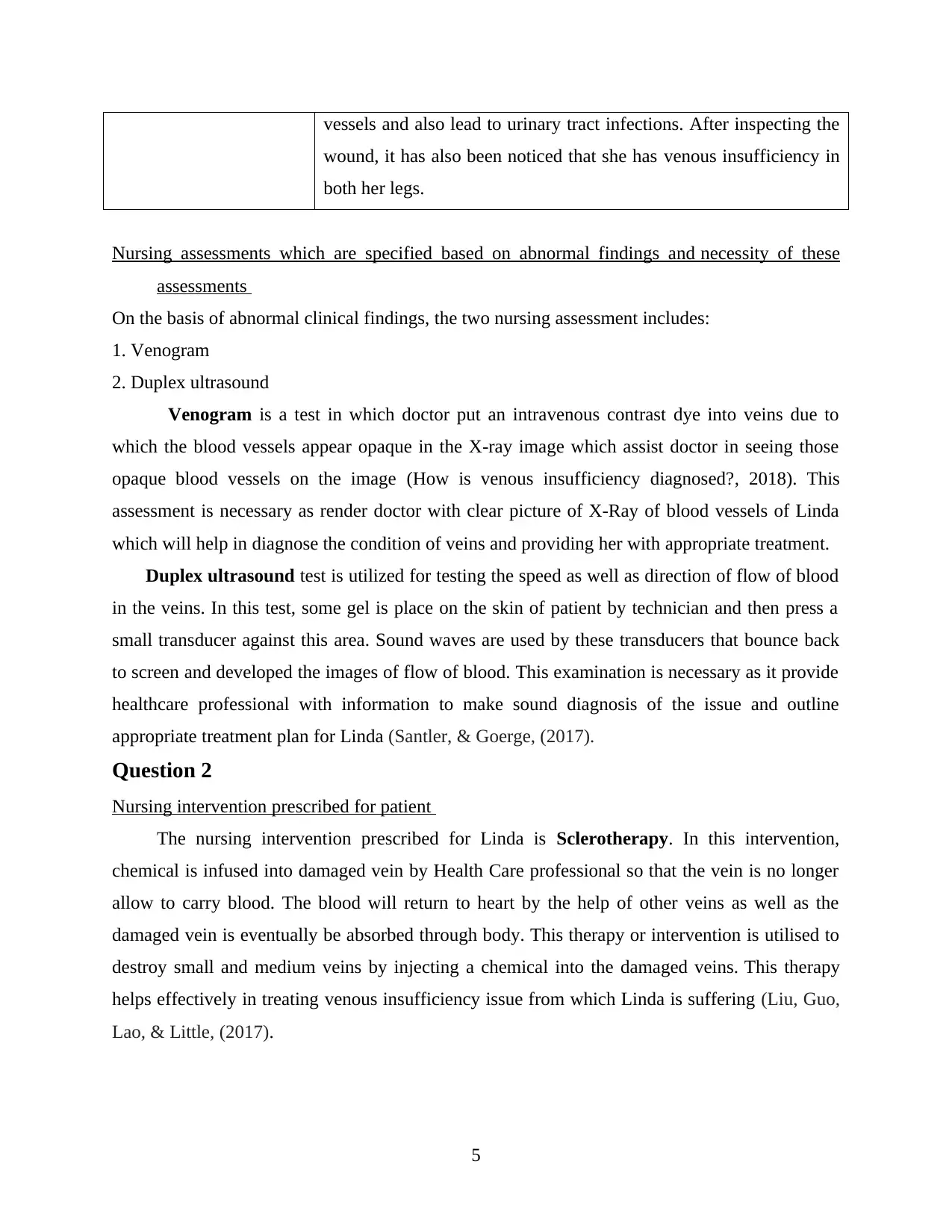
vessels and also lead to urinary tract infections. After inspecting the
wound, it has also been noticed that she has venous insufficiency in
both her legs.
Nursing assessments which are specified based on abnormal findings and necessity of these
assessments
On the basis of abnormal clinical findings, the two nursing assessment includes:
1. Venogram
2. Duplex ultrasound
Venogram is a test in which doctor put an intravenous contrast dye into veins due to
which the blood vessels appear opaque in the X-ray image which assist doctor in seeing those
opaque blood vessels on the image (How is venous insufficiency diagnosed?, 2018). This
assessment is necessary as render doctor with clear picture of X-Ray of blood vessels of Linda
which will help in diagnose the condition of veins and providing her with appropriate treatment.
Duplex ultrasound test is utilized for testing the speed as well as direction of flow of blood
in the veins. In this test, some gel is place on the skin of patient by technician and then press a
small transducer against this area. Sound waves are used by these transducers that bounce back
to screen and developed the images of flow of blood. This examination is necessary as it provide
healthcare professional with information to make sound diagnosis of the issue and outline
appropriate treatment plan for Linda (Santler, & Goerge, (2017).
Question 2
Nursing intervention prescribed for patient
The nursing intervention prescribed for Linda is Sclerotherapy. In this intervention,
chemical is infused into damaged vein by Health Care professional so that the vein is no longer
allow to carry blood. The blood will return to heart by the help of other veins as well as the
damaged vein is eventually be absorbed through body. This therapy or intervention is utilised to
destroy small and medium veins by injecting a chemical into the damaged veins. This therapy
helps effectively in treating venous insufficiency issue from which Linda is suffering (Liu, Guo,
Lao, & Little, (2017).
5
wound, it has also been noticed that she has venous insufficiency in
both her legs.
Nursing assessments which are specified based on abnormal findings and necessity of these
assessments
On the basis of abnormal clinical findings, the two nursing assessment includes:
1. Venogram
2. Duplex ultrasound
Venogram is a test in which doctor put an intravenous contrast dye into veins due to
which the blood vessels appear opaque in the X-ray image which assist doctor in seeing those
opaque blood vessels on the image (How is venous insufficiency diagnosed?, 2018). This
assessment is necessary as render doctor with clear picture of X-Ray of blood vessels of Linda
which will help in diagnose the condition of veins and providing her with appropriate treatment.
Duplex ultrasound test is utilized for testing the speed as well as direction of flow of blood
in the veins. In this test, some gel is place on the skin of patient by technician and then press a
small transducer against this area. Sound waves are used by these transducers that bounce back
to screen and developed the images of flow of blood. This examination is necessary as it provide
healthcare professional with information to make sound diagnosis of the issue and outline
appropriate treatment plan for Linda (Santler, & Goerge, (2017).
Question 2
Nursing intervention prescribed for patient
The nursing intervention prescribed for Linda is Sclerotherapy. In this intervention,
chemical is infused into damaged vein by Health Care professional so that the vein is no longer
allow to carry blood. The blood will return to heart by the help of other veins as well as the
damaged vein is eventually be absorbed through body. This therapy or intervention is utilised to
destroy small and medium veins by injecting a chemical into the damaged veins. This therapy
helps effectively in treating venous insufficiency issue from which Linda is suffering (Liu, Guo,
Lao, & Little, (2017).
5
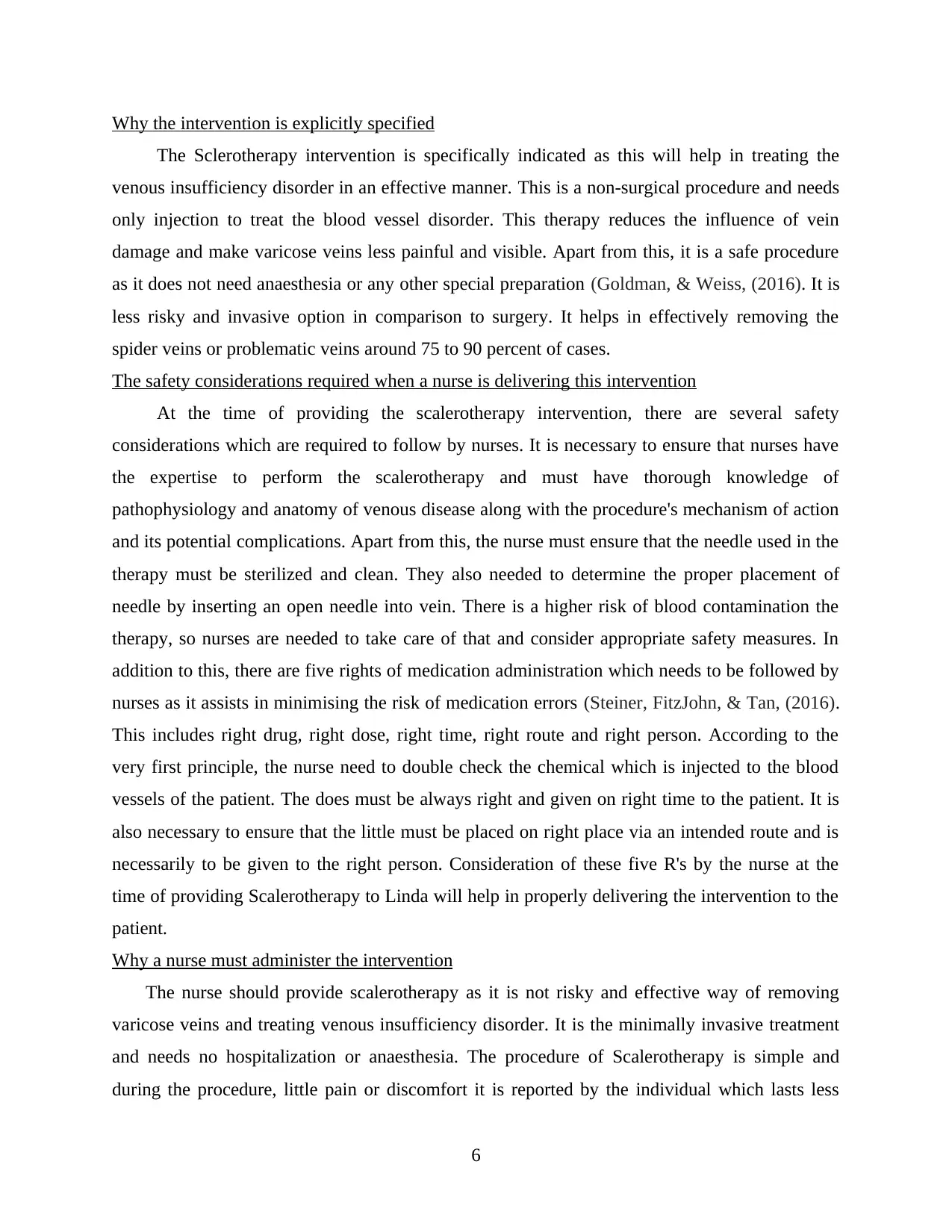
Why the intervention is explicitly specified
The Sclerotherapy intervention is specifically indicated as this will help in treating the
venous insufficiency disorder in an effective manner. This is a non-surgical procedure and needs
only injection to treat the blood vessel disorder. This therapy reduces the influence of vein
damage and make varicose veins less painful and visible. Apart from this, it is a safe procedure
as it does not need anaesthesia or any other special preparation (Goldman, & Weiss, (2016). It is
less risky and invasive option in comparison to surgery. It helps in effectively removing the
spider veins or problematic veins around 75 to 90 percent of cases.
The safety considerations required when a nurse is delivering this intervention
At the time of providing the scalerotherapy intervention, there are several safety
considerations which are required to follow by nurses. It is necessary to ensure that nurses have
the expertise to perform the scalerotherapy and must have thorough knowledge of
pathophysiology and anatomy of venous disease along with the procedure's mechanism of action
and its potential complications. Apart from this, the nurse must ensure that the needle used in the
therapy must be sterilized and clean. They also needed to determine the proper placement of
needle by inserting an open needle into vein. There is a higher risk of blood contamination the
therapy, so nurses are needed to take care of that and consider appropriate safety measures. In
addition to this, there are five rights of medication administration which needs to be followed by
nurses as it assists in minimising the risk of medication errors (Steiner, FitzJohn, & Tan, (2016).
This includes right drug, right dose, right time, right route and right person. According to the
very first principle, the nurse need to double check the chemical which is injected to the blood
vessels of the patient. The does must be always right and given on right time to the patient. It is
also necessary to ensure that the little must be placed on right place via an intended route and is
necessarily to be given to the right person. Consideration of these five R's by the nurse at the
time of providing Scalerotherapy to Linda will help in properly delivering the intervention to the
patient.
Why a nurse must administer the intervention
The nurse should provide scalerotherapy as it is not risky and effective way of removing
varicose veins and treating venous insufficiency disorder. It is the minimally invasive treatment
and needs no hospitalization or anaesthesia. The procedure of Scalerotherapy is simple and
during the procedure, little pain or discomfort it is reported by the individual which lasts less
6
The Sclerotherapy intervention is specifically indicated as this will help in treating the
venous insufficiency disorder in an effective manner. This is a non-surgical procedure and needs
only injection to treat the blood vessel disorder. This therapy reduces the influence of vein
damage and make varicose veins less painful and visible. Apart from this, it is a safe procedure
as it does not need anaesthesia or any other special preparation (Goldman, & Weiss, (2016). It is
less risky and invasive option in comparison to surgery. It helps in effectively removing the
spider veins or problematic veins around 75 to 90 percent of cases.
The safety considerations required when a nurse is delivering this intervention
At the time of providing the scalerotherapy intervention, there are several safety
considerations which are required to follow by nurses. It is necessary to ensure that nurses have
the expertise to perform the scalerotherapy and must have thorough knowledge of
pathophysiology and anatomy of venous disease along with the procedure's mechanism of action
and its potential complications. Apart from this, the nurse must ensure that the needle used in the
therapy must be sterilized and clean. They also needed to determine the proper placement of
needle by inserting an open needle into vein. There is a higher risk of blood contamination the
therapy, so nurses are needed to take care of that and consider appropriate safety measures. In
addition to this, there are five rights of medication administration which needs to be followed by
nurses as it assists in minimising the risk of medication errors (Steiner, FitzJohn, & Tan, (2016).
This includes right drug, right dose, right time, right route and right person. According to the
very first principle, the nurse need to double check the chemical which is injected to the blood
vessels of the patient. The does must be always right and given on right time to the patient. It is
also necessary to ensure that the little must be placed on right place via an intended route and is
necessarily to be given to the right person. Consideration of these five R's by the nurse at the
time of providing Scalerotherapy to Linda will help in properly delivering the intervention to the
patient.
Why a nurse must administer the intervention
The nurse should provide scalerotherapy as it is not risky and effective way of removing
varicose veins and treating venous insufficiency disorder. It is the minimally invasive treatment
and needs no hospitalization or anaesthesia. The procedure of Scalerotherapy is simple and
during the procedure, little pain or discomfort it is reported by the individual which lasts less
6
⊘ This is a preview!⊘
Do you want full access?
Subscribe today to unlock all pages.

Trusted by 1+ million students worldwide
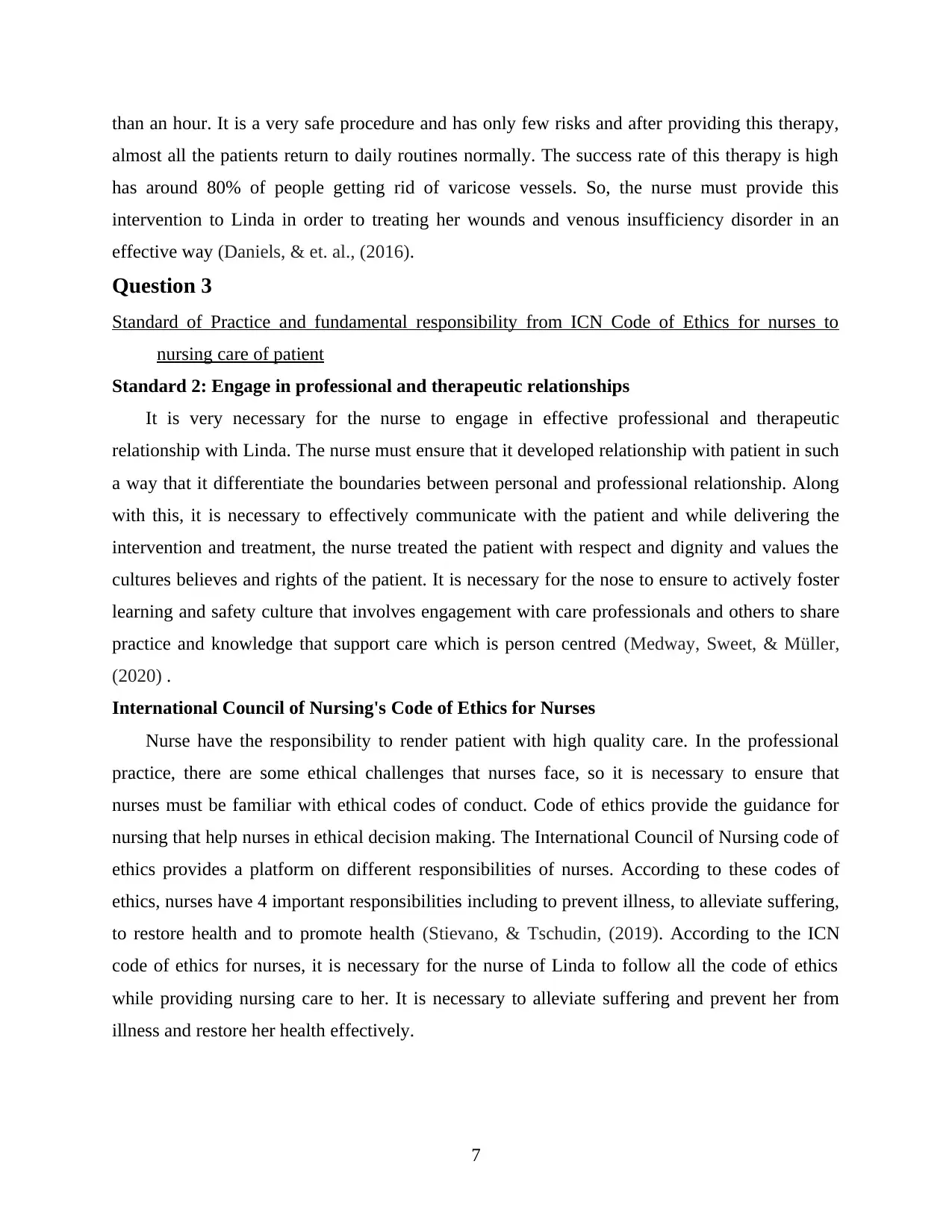
than an hour. It is a very safe procedure and has only few risks and after providing this therapy,
almost all the patients return to daily routines normally. The success rate of this therapy is high
has around 80% of people getting rid of varicose vessels. So, the nurse must provide this
intervention to Linda in order to treating her wounds and venous insufficiency disorder in an
effective way (Daniels, & et. al., (2016).
Question 3
Standard of Practice and fundamental responsibility from ICN Code of Ethics for nurses to
nursing care of patient
Standard 2: Engage in professional and therapeutic relationships
It is very necessary for the nurse to engage in effective professional and therapeutic
relationship with Linda. The nurse must ensure that it developed relationship with patient in such
a way that it differentiate the boundaries between personal and professional relationship. Along
with this, it is necessary to effectively communicate with the patient and while delivering the
intervention and treatment, the nurse treated the patient with respect and dignity and values the
cultures believes and rights of the patient. It is necessary for the nose to ensure to actively foster
learning and safety culture that involves engagement with care professionals and others to share
practice and knowledge that support care which is person centred (Medway, Sweet, & Müller,
(2020) .
International Council of Nursing's Code of Ethics for Nurses
Nurse have the responsibility to render patient with high quality care. In the professional
practice, there are some ethical challenges that nurses face, so it is necessary to ensure that
nurses must be familiar with ethical codes of conduct. Code of ethics provide the guidance for
nursing that help nurses in ethical decision making. The International Council of Nursing code of
ethics provides a platform on different responsibilities of nurses. According to these codes of
ethics, nurses have 4 important responsibilities including to prevent illness, to alleviate suffering,
to restore health and to promote health (Stievano, & Tschudin, (2019). According to the ICN
code of ethics for nurses, it is necessary for the nurse of Linda to follow all the code of ethics
while providing nursing care to her. It is necessary to alleviate suffering and prevent her from
illness and restore her health effectively.
7
almost all the patients return to daily routines normally. The success rate of this therapy is high
has around 80% of people getting rid of varicose vessels. So, the nurse must provide this
intervention to Linda in order to treating her wounds and venous insufficiency disorder in an
effective way (Daniels, & et. al., (2016).
Question 3
Standard of Practice and fundamental responsibility from ICN Code of Ethics for nurses to
nursing care of patient
Standard 2: Engage in professional and therapeutic relationships
It is very necessary for the nurse to engage in effective professional and therapeutic
relationship with Linda. The nurse must ensure that it developed relationship with patient in such
a way that it differentiate the boundaries between personal and professional relationship. Along
with this, it is necessary to effectively communicate with the patient and while delivering the
intervention and treatment, the nurse treated the patient with respect and dignity and values the
cultures believes and rights of the patient. It is necessary for the nose to ensure to actively foster
learning and safety culture that involves engagement with care professionals and others to share
practice and knowledge that support care which is person centred (Medway, Sweet, & Müller,
(2020) .
International Council of Nursing's Code of Ethics for Nurses
Nurse have the responsibility to render patient with high quality care. In the professional
practice, there are some ethical challenges that nurses face, so it is necessary to ensure that
nurses must be familiar with ethical codes of conduct. Code of ethics provide the guidance for
nursing that help nurses in ethical decision making. The International Council of Nursing code of
ethics provides a platform on different responsibilities of nurses. According to these codes of
ethics, nurses have 4 important responsibilities including to prevent illness, to alleviate suffering,
to restore health and to promote health (Stievano, & Tschudin, (2019). According to the ICN
code of ethics for nurses, it is necessary for the nurse of Linda to follow all the code of ethics
while providing nursing care to her. It is necessary to alleviate suffering and prevent her from
illness and restore her health effectively.
7
Paraphrase This Document
Need a fresh take? Get an instant paraphrase of this document with our AI Paraphraser
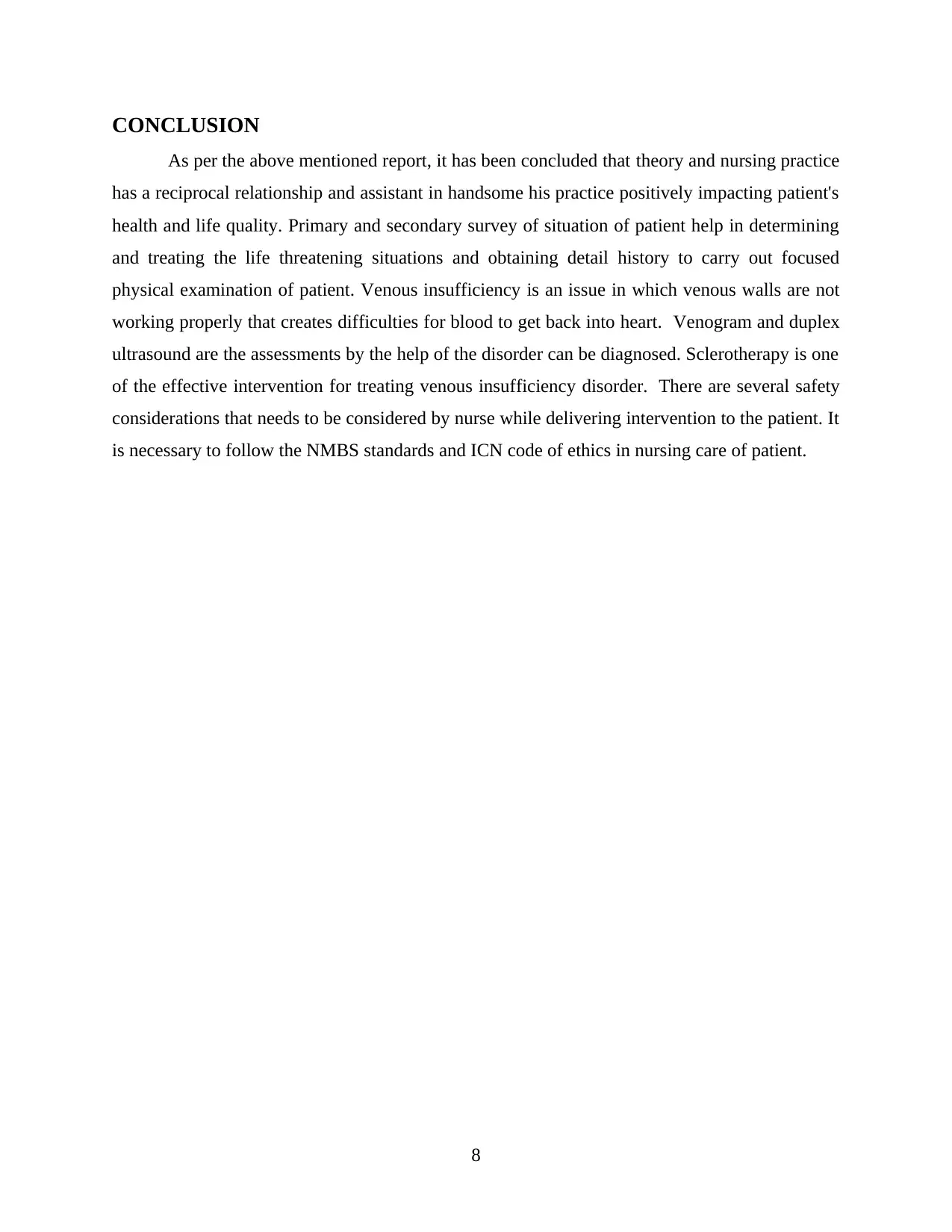
CONCLUSION
As per the above mentioned report, it has been concluded that theory and nursing practice
has a reciprocal relationship and assistant in handsome his practice positively impacting patient's
health and life quality. Primary and secondary survey of situation of patient help in determining
and treating the life threatening situations and obtaining detail history to carry out focused
physical examination of patient. Venous insufficiency is an issue in which venous walls are not
working properly that creates difficulties for blood to get back into heart. Venogram and duplex
ultrasound are the assessments by the help of the disorder can be diagnosed. Sclerotherapy is one
of the effective intervention for treating venous insufficiency disorder. There are several safety
considerations that needs to be considered by nurse while delivering intervention to the patient. It
is necessary to follow the NMBS standards and ICN code of ethics in nursing care of patient.
8
As per the above mentioned report, it has been concluded that theory and nursing practice
has a reciprocal relationship and assistant in handsome his practice positively impacting patient's
health and life quality. Primary and secondary survey of situation of patient help in determining
and treating the life threatening situations and obtaining detail history to carry out focused
physical examination of patient. Venous insufficiency is an issue in which venous walls are not
working properly that creates difficulties for blood to get back into heart. Venogram and duplex
ultrasound are the assessments by the help of the disorder can be diagnosed. Sclerotherapy is one
of the effective intervention for treating venous insufficiency disorder. There are several safety
considerations that needs to be considered by nurse while delivering intervention to the patient. It
is necessary to follow the NMBS standards and ICN code of ethics in nursing care of patient.
8
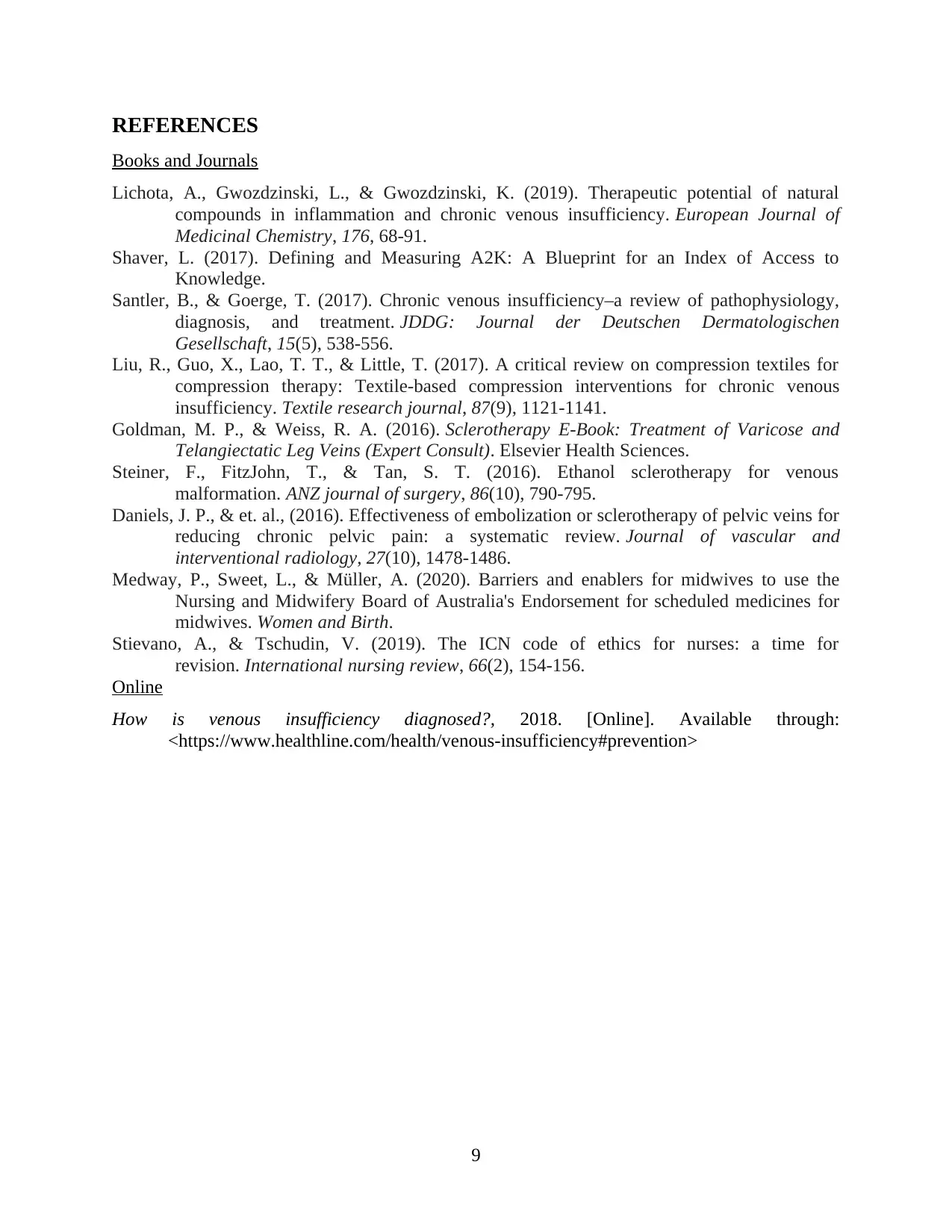
REFERENCES
Books and Journals
Lichota, A., Gwozdzinski, L., & Gwozdzinski, K. (2019). Therapeutic potential of natural
compounds in inflammation and chronic venous insufficiency. European Journal of
Medicinal Chemistry, 176, 68-91.
Shaver, L. (2017). Defining and Measuring A2K: A Blueprint for an Index of Access to
Knowledge.
Santler, B., & Goerge, T. (2017). Chronic venous insufficiency–a review of pathophysiology,
diagnosis, and treatment. JDDG: Journal der Deutschen Dermatologischen
Gesellschaft, 15(5), 538-556.
Liu, R., Guo, X., Lao, T. T., & Little, T. (2017). A critical review on compression textiles for
compression therapy: Textile-based compression interventions for chronic venous
insufficiency. Textile research journal, 87(9), 1121-1141.
Goldman, M. P., & Weiss, R. A. (2016). Sclerotherapy E-Book: Treatment of Varicose and
Telangiectatic Leg Veins (Expert Consult). Elsevier Health Sciences.
Steiner, F., FitzJohn, T., & Tan, S. T. (2016). Ethanol sclerotherapy for venous
malformation. ANZ journal of surgery, 86(10), 790-795.
Daniels, J. P., & et. al., (2016). Effectiveness of embolization or sclerotherapy of pelvic veins for
reducing chronic pelvic pain: a systematic review. Journal of vascular and
interventional radiology, 27(10), 1478-1486.
Medway, P., Sweet, L., & Müller, A. (2020). Barriers and enablers for midwives to use the
Nursing and Midwifery Board of Australia's Endorsement for scheduled medicines for
midwives. Women and Birth.
Stievano, A., & Tschudin, V. (2019). The ICN code of ethics for nurses: a time for
revision. International nursing review, 66(2), 154-156.
Online
How is venous insufficiency diagnosed?, 2018. [Online]. Available through:
<https://www.healthline.com/health/venous-insufficiency#prevention>
9
Books and Journals
Lichota, A., Gwozdzinski, L., & Gwozdzinski, K. (2019). Therapeutic potential of natural
compounds in inflammation and chronic venous insufficiency. European Journal of
Medicinal Chemistry, 176, 68-91.
Shaver, L. (2017). Defining and Measuring A2K: A Blueprint for an Index of Access to
Knowledge.
Santler, B., & Goerge, T. (2017). Chronic venous insufficiency–a review of pathophysiology,
diagnosis, and treatment. JDDG: Journal der Deutschen Dermatologischen
Gesellschaft, 15(5), 538-556.
Liu, R., Guo, X., Lao, T. T., & Little, T. (2017). A critical review on compression textiles for
compression therapy: Textile-based compression interventions for chronic venous
insufficiency. Textile research journal, 87(9), 1121-1141.
Goldman, M. P., & Weiss, R. A. (2016). Sclerotherapy E-Book: Treatment of Varicose and
Telangiectatic Leg Veins (Expert Consult). Elsevier Health Sciences.
Steiner, F., FitzJohn, T., & Tan, S. T. (2016). Ethanol sclerotherapy for venous
malformation. ANZ journal of surgery, 86(10), 790-795.
Daniels, J. P., & et. al., (2016). Effectiveness of embolization or sclerotherapy of pelvic veins for
reducing chronic pelvic pain: a systematic review. Journal of vascular and
interventional radiology, 27(10), 1478-1486.
Medway, P., Sweet, L., & Müller, A. (2020). Barriers and enablers for midwives to use the
Nursing and Midwifery Board of Australia's Endorsement for scheduled medicines for
midwives. Women and Birth.
Stievano, A., & Tschudin, V. (2019). The ICN code of ethics for nurses: a time for
revision. International nursing review, 66(2), 154-156.
Online
How is venous insufficiency diagnosed?, 2018. [Online]. Available through:
<https://www.healthline.com/health/venous-insufficiency#prevention>
9
⊘ This is a preview!⊘
Do you want full access?
Subscribe today to unlock all pages.

Trusted by 1+ million students worldwide
1 out of 9
Related Documents
Your All-in-One AI-Powered Toolkit for Academic Success.
+13062052269
info@desklib.com
Available 24*7 on WhatsApp / Email
![[object Object]](/_next/static/media/star-bottom.7253800d.svg)
Unlock your academic potential
Copyright © 2020–2025 A2Z Services. All Rights Reserved. Developed and managed by ZUCOL.





